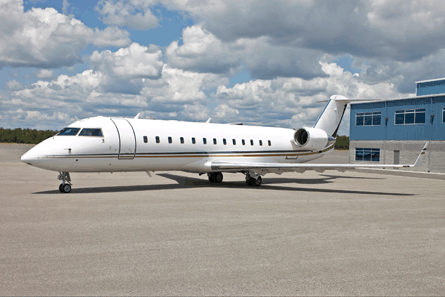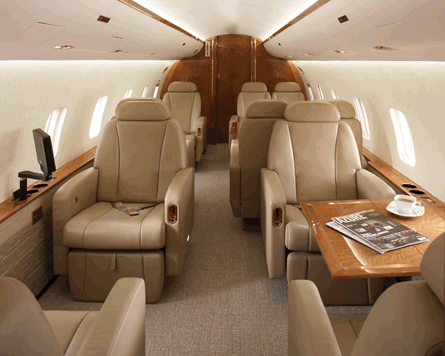Dubai-based Project Phoenix, a company that restores ex-airline Bombardier CRJ200s for the business aviation market, passed a momentous milestone in October - it delivered its first aircraft, a VIP CRJ200 to a Macau-based businessman who is using the aircraft for flights into mainland China.
Since then, not much has happened.
"We're doing great, but I'd like to sell a few more aircraft," says Project Phoenix president Mike Cappuccitti. Rather than moving forward in assembly line-style building spec aircraft, Cappuccitti's business model calls for selling each Phoenix before he purchases a previously owned aircraft and begins a restoration and conversion.
"We do a 100% customisation approach," he says. "We sell it first, right down to whether they want 5,000h or 15,000h on the airframe, then we customise it."
The Macau aircraft had 18,000h on the airframe before it was refurbished by Project Phoenix completion partner, Flying Colours in Peterborough, Ontario, Canada. Included in the customisation were dual electronic flight bags in the cockpit along with dual HF radios and a second flight management system. "They'll be doing quite a bit of overwater flying," says Cappuccitti.
 |
|---|
© Project Phoenix |
While the number of hours on the airframe might seem high, there are mitigating factors. A secondhand aircraft allows for the baseline cost of a Phoenix to be $18.5 million compared with a new Bombardier Challenger 850 at $32 million, and the number of hours on the airframe is relative - the CRJ is built with an 80,000 cycle life limit, says Cappuccitti, and Project Phoenix "resets" engines, auxiliary power units and landing gear to 4,000 cycles or less at the start of a conversion.
"Even a Phoenix with 20,000 cycles when we take it still has more life than a new Embraer Legacy 600," says Cappuccitti. The Legacy 600, which Cappuccitti says has a 50,000 cycle airframe, is an executive version of the ERJ-135 regional jet, available for $25 million new from Embraer.
"We do minimum of 96-month check and all checks up to that point. We rewire and replumb where necessary, and go through every single system replacing components and valves and everything we need to bring the aircraft up to manufacturer standards," he say. "No detail is too small."
Accentuating the point, he says the Project puts 200 man-hours into polishing out the metallic leading edges of the wings to get rid of pitting. "We replace any window that isn't perfect," he adds.
From a performance standpoint, the Phoenix CRJ has the same challenges as the Challenger 850 - it needs a lot of runway. "At maximum take-off weight, we require a longish runway, depending on altitude and temperature," says Cappuccitti.
"But that's why we go for the CRJ200 series and its more-powerful engines as opposed to the CRJ100. Also helping performance is that the company does not include long-range fuel tanks as standard equipment.
"For 70-75% of the people we're talking to, it makes no difference in their operation," he says. "It gives you 50% more baggage area and payload, and that means you can take off on virtually any day with any passenger load." Under those conditions, he says the aircraft needs about 1,980m (6,500ft) of runway for maximum weight take-off.
"If the aircraft was based in Istanbul, you could reach all of Europe and Middle East," he says. "From Dubai, you would need one stop to get to London. If you want to go Dubai non-stop to London, then you're going to pay $35-40 million for the pleasure," he says, referring to the price tag of longer-range, large-cabin aircraft such as the Gulfstream G500, Bombardier Global Express and Dassault Falcon 900.
"It's a trade-off between performance and cabin", he adds.
So why are more of these cabin-conscious niche customers not making the leap?
"We have a lot of potentials, but they're waiting for liquidity to return," says Cappuccitti. "Closing a deal in this economic environment is tough, although we're pretty bullish about the future."
 |
|---|
© Project Phoenix |
Helping the company to keep operating, in the meantime, is its business model, which does not require Phoenix to pay for white tails sitting on the ramp.
When that next customer does come forward, Cappuccitti says the delivery pipeline will be greatly contracted, down to nine months from 14 on the first Phoenix CRJ. Total time for the first conversion was affected by new US Federal Aviation Administration rules for preventing the potential for explosions in auxiliary fuel tanks and associated requirements for temperature shielding between the tanks and adjacent baggage areas.
The aircraft also had some issues with its cabin management system, which required rewrite of its software, says Cappuccitti.
Dubai-based Project Phoenix, a company that restores ex-airline Bombardier CRJ200s for the business aviation market, passed a momentous milestone in October - it delivered its first aircraft, a VIP CRJ200 to a Macau-based businessman who is using the aircraft for flights into mainland China.
Since then, not much has happened.
"We're doing great, but I'd like to sell a few more aircraft," says Project Phoenix president Mike Cappuccitti. Rather than moving forward in assembly line-style building spec aircraft, Cappuccitti's business model calls for selling each Phoenix before he purchases a previously owned aircraft and begins a restoration and conversion.
"We do a 100% customisation approach," he says. "We sell it first, right down to whether they want 5,000h or 15,000h on the airframe, then we customise it."
The Macau aircraft had 18,000h on the airframe before it was refurbished by Project Phoenix completion partner, Flying Colours in Peterborough, Ontario, Canada. Included in the customisation were dual electronic flight bags in the cockpit along with dual HF radios and a second flight management system. "They'll be doing quite a bit of overwater flying," says Cappuccitti.
While the number of hours on the airframe might seem high, there are mitigating factors. A secondhand aircraft allows for the baseline cost of a Phoenix to be $18.5 million compared with a new Bombardier Challenger 850 at $32 million, and the number of hours on the airframe is relative - the CRJ is built with an 80,000 cycle life limit, says Cappuccitti, and Project Phoenix "resets" engines, auxiliary power units and landing gear to 4,000 cycles or less at the start of a conversion.
"Even a Phoenix with 20,000 cycles when we take it still has more life than a new Embraer Legacy 600," says Cappuccitti. The Legacy 600, which Cappuccitti says has a 50,000 cycle airframe, is an executive version of the ERJ-135 regional jet, available for $25 million new from Embraer.
"We do minimum of 96-month check and all checks up to that point. We rewire and replumb where necessary, and go through every single system replacing components and valves and everything we need to bring the aircraft up to manufacturer standards," he say. "No detail is too small."
Accentuating the point, he says the Project puts 200 man-hours into polishing out the metallic leading edges of the wings to get rid of pitting. "We replace any window that isn't perfect," he adds.
From a performance standpoint, the Phoenix CRJ has the same challenges as the Challenger 850 - it needs a lot of runway. "At maximum take-off weight, we require a longish runway, depending on altitude and temperature," says Cappuccitti. "But that's why we go for the CRJ200 series and its more-powerful engines as opposed to the CRJ100. Also helping performance is that the company does not include long-range fuel tanks as standard equipment.
"For 70-75% of the people we're talking to, it makes no difference in their operation," he says. "It gives you 50% more baggage area and payload, and that means you can take off on virtually any day with any passenger load." Under those conditions, he says the aircraft needs about 1,980m (6,500ft) of runway for maximum weight take-off.
"If the aircraft was based in Istanbul, you could reach all of Europe and Middle East," he says. "From Dubai, you would need one stop to get to London. If you want to go Dubai non-stop to London, then you're going to pay $35-40 million for the pleasure," he says, referring to the price tag of longer-range, large-cabin aircraft such as the Gulfstream G500, Bombardier Global Express and Dassault Falcon 900. "It's a trade-off between performance and cabin", he adds.
So why are more of these cabin-conscious niche customers not making the leap?
"We have a lot of potentials, but they're waiting for liquidity to return," says Cappuccitti. "Closing a deal in this economic environment is tough, although we're pretty bullish about the future."
Helping the company to keep operating, in the meantime, is its business model, which does not require Phoenix to pay for white tails sitting on the ramp.
When that next customer does come forward, Cappuccitti says the delivery pipeline will be greatly contracted, down to nine months from 14 on the first Phoenix CRJ. Total time for the first conversion was affected by new US Federal Aviation Administration rules for preventing the potential for explosions in auxiliary fuel tanks and associated requirements for temperature shielding between the tanks and adjacent baggage areas. The aircraft also had some issues with its cabin management system, which required rewrite of its software, says Cappuccitti.
Source: Flight International























